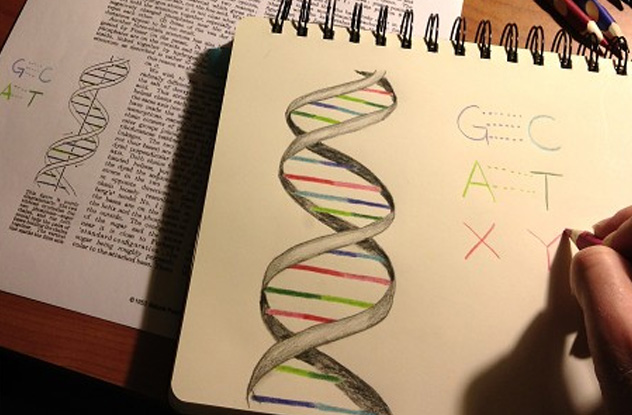 Our World
Our World  Our World
Our World  Weird Stuff
Weird Stuff 10 Fascinating Facts You Might Not Know About Snow
 Miscellaneous
Miscellaneous Top 10 Things Crypto Was Supposed to Change & What Actually Did
 History
History 10 Huge Historical Events That Happened on Christmas Eve
 Music
Music 10 Surprising Origin Stories of Your Favorite Holiday Songs
 History
History 10 Less Than Jolly Events That Occurred on December 25
 Weird Stuff
Weird Stuff 10 Funny Ways That Researchers Overthink Christmas
 Politics
Politics 10 Political Scandals That Sent Crowds Into the Streets
 Weird Stuff
Weird Stuff Ten Bizarre Facts About The Doge Meme
 Our World
Our World 10 Ways Your Christmas Tree Is More Lit Than You Think
 Our World
Our World 10 Archaeological Discoveries of 2025 That Refined History
 Weird Stuff
Weird Stuff 10 Fascinating Facts You Might Not Know About Snow
 Miscellaneous
Miscellaneous Top 10 Things Crypto Was Supposed to Change & What Actually Did
Who's Behind Listverse?

Jamie Frater
Head Editor
Jamie founded Listverse due to an insatiable desire to share fascinating, obscure, and bizarre facts. He has been a guest speaker on numerous national radio and television stations and is a five time published author.
More About Us History
History 10 Huge Historical Events That Happened on Christmas Eve
 Music
Music 10 Surprising Origin Stories of Your Favorite Holiday Songs
 History
History 10 Less Than Jolly Events That Occurred on December 25
 Weird Stuff
Weird Stuff 10 Funny Ways That Researchers Overthink Christmas
 Politics
Politics 10 Political Scandals That Sent Crowds Into the Streets
 Weird Stuff
Weird Stuff Ten Bizarre Facts About The Doge Meme
 Our World
Our World 10 Ways Your Christmas Tree Is More Lit Than You Think
10 Scientific Projects Where Men Played God
Science has greatly improved our lives, made our world a more convenient place to live in, and helped us gain a better understanding of ourselves and our universe. As science progresses, so does humanity. With this in mind, many researchers are eager to embark on scientific projects that can potentially revolutionize and benefit all of mankind. However, there are times when scientific progress, innovation, and discoveries can only be made if scientists take the role of God.
10Bringing An Animal Back From Extinction

The Pyrenean ibex, or bucardo, was a wild goat that lived high in the Pyrenees—the mountain range that divides France and Spain. For thousands of years, these animals thrived in the region, but due to excessive hunting, they were driven to extinction. However, before the last bucardo (a female named Celia) died, scientists were able to preserve her intact cells.
Several years after the animal was officially declared extinct, a team of French and Spanish scientists embarked on a controversial scientific project reminiscent of the classic sci-fi novel Jurassic Park—they brought a bucardo (Celia’s clone) back from extinction. Sadly, she didn’t live long. She died 10 minutes after her surrogate mother gave birth to her.
Scientists call the process of bringing vanished species back to life de-extinction. When the bucardo underwent de-extinction in 2003, the tools that scientists used were “woefully crude.” However, with new advanced equipment, scientists are hopeful that they will eventually perfect the process of de-extinction. With this in mind, it is only a matter of time till extinct animals will once again roam Earth.
9Manipulating Earth’s Natural Systems

Climate change caused by global warming is getting steadily worse, and the measures we are currently implementing are ineffective. To solve climate change once and for all, many scientists are calling for geoengineering techniques. However, this practice is quite controversial. Many of the proposed solutions are either high-risk or too out-of-this-world to be taken seriously.
Geoengineering is the deliberate intervention in Earth’s environmental processes. There are many proposed techniques, but the two that are seriously considered by the scientific community are carbon dioxide removal and solar radiation management.
Carbon dioxide removal is low-risk but relatively expensive. In addition, its effects are quite minimal, and it might take a long time before significant results can be felt. On the other hand, solar radiation management, also called albedo modification, is inexpensive but relatively high-risk. This technique is far more effective than carbon dioxide removal and can immediately lower Earth’s temperature. However, it can also cause irreversible damages, such as altering Earth’s weather patterns. In addition, albedo modification can be used as a weapon by terrorists or governments.
8Developing Gene-Engineered Mosquitoes

Malaria is a global problem. In 2013, it infected more than 198 million people. Though there is a vaccine, it is ineffective. Aside from that, the parasite that causes malaria can quickly develop resistance against drugs. All these factors make this disease one of the most difficult to eradicate. Even with advanced technology, the main tools used to combat this disease are pesticides and bed nets.
However, there is hope. Scientists from the University of California Irvine successfully engineered mosquitoes that cannot be infected with the malaria parasite. In addition, the malaria-resistant insects they have genetically created are capable of passing the trait to future generations and spreading it to big mosquito populations. Though it might not completely eradicate malaria, the researchers are hoping that their controversial but effective method will help in minimizing this global problem.
Aside from malaria, this innovative technology can also be used to solve other “arthropod-transmitted diseases that affect humans and crops and for which the use of insecticides continues to be the main tool.”
7Recreating Interstellar Dust

Understanding the composition and evolution of the universe is one of the major objectives of NASA. In its quest to fully comprehend the universe, NASA faced one big challenge—creating interstellar and planetary materials in a laboratory setting. This has been a major challenge for many decades. However, in 2014, NASA made a significant breakthrough. By playing God, they were able to create interstellar dust.
They used a low-pressure chamber called Cosmic Simulation Chamber to create interstellar dust. This chamber is capable of recreating deep space environment by simulating extreme levels of temperatures and vacuum.
NASA used the Cosmic Simulation Chamber to recreate the extreme conditions surrounding a dying star. When a dying star, also called a red giant, is nearing the end of its life, it starts to eject massive amounts of interstellar dust, which scientists consider to be the foundation of “planetary formation and act[s] as a key component in the evolution of the universe.” By recreating this extraterrestrial material, NASA researchers are hopeful that they will be able to unlock the mysteries of our vast universe.
6Creating Artificial Sperm

Infertility is a sensitive global issue. Though both sexes can experience this problem, it mainly occurs in men. Male infertility happens when the germ cells in the testes are unable to undergo a type of cell division called meiosis. When meiosis does not occur, the germ cells do not transform into fully functional sperm cells. Currently, the only solution to this problem involves sperm donors.
However, there is hope for infertile men. Scientists in China were able to create artificial semen in the lab. They extracted embryonic stem cells (which can become any type of cell) from a mouse and then exposed them to various chemicals. The result was primordial germ cells. They then exposed these germ cells to sex hormones and testicular cells. After some time, the germ cells transformed into fully functional sperm cells. The scientists then injected the sperm cells into female mice who later on gave birth to healthy babies.
Researchers plan on conducting further experiments on primates. If the results are positive, they will proceed into human trials. Though it’s controversial, this method can potentially end the need for sperm donors and enable infertile men to father their own biological children.
5Developing Human-Animal Hybrid Organs

There is an undeniable shortage of donor organs worldwide. In the United States alone, 22 people die every day while waiting for organ transplants. Because of this, numerous scientists are starting to look into an innovative but controversial alternative—“growing” human organs inside animals.
Known as chimera, this mix of animal and human DNA in modern medicine was inspired from a monster in Greek mythology, which was part snake, part lion, and part goat.
The process of creating chimeras is pretty straightforward. Scientists will remove a section of an animal’s DNA. It can be anything, such as a section that codes the growth of pancreas. Afterward, they will then inject human stem cells into the animal’s embryo. Once inside the embryo, the stem cells will start developing the missing section in the DNA. Since embryos do not have immune systems, the human stem cells won’t be rejected.
Though this scientific project has the potential to save thousands of lives each year, it has been criticized heavily. Aside from the fact that this scientific project involves scientists playing God, there is also the concern of what if the stem cells start to create a human brain inside the host animal. What will be the implications or consequences of creating human-animal hybrids that are capable of thinking?
4Resurrecting Brain-Dead People

Resurrecting the dead seems like an impossible feat, something that only exists in religious and supernatural stories. However, an American company called BioQuark is working ardently to achieve this seemingly unattainable goal. Just recently, BioQuark received permission by the US Institutional Review Board to start the first part of its ambitious, controversial project. This phase is called ReAnima, and it involves the identification of 20 people from India who have been declared legally and clinically dead.
However, it is important to note that BioQuark will only conduct its experiments on brain-dead people. Brain death can be defined succinctly as losing all brain functions. A brain-dead person might be legally or clinically pronounced dead but can still be kept alive through life support.
In its goal to resurrect the brain-dead, BioQuark plans on using several techniques, such as peptide injections, stem cells, and nerve stimulations that will trigger the central nervous system and certain sections of the brain “to repair and regrow themselves [in] the [same] way some fish and amphibians can.” Once BioQuark succeeds in resurrecting the brain-dead, it will devote its time in achieving “complete human re-animation.”
3Editing Human Genes

In the past, genetic editing was only confined to animals and plants. But now it is being “aimed squarely at humanity.” This happened after the Human Fertilization and Embryology Authority in England gave Kathy Niakan, a researcher from London’s Francis Crick Institute, permission to edit human embryos for scientific purposes.
The technology that Niakan and other geneticists use is called CRISPR or Clustered Regularly Interspaced Palindromic Repeats. This technology enables scientists to identify certain genes, remove them, and then rewrite their DNA. CRISPR is not new. In fact, it has been used to edit the genes of dogs to make them bigger and pigs to make them smaller.
Though it’s controversial, human genetic editing has a noble purpose. As a technology, it aims to eliminate certain diseases like cancer, lessen miscarriages, and improve fertility rates. However, human genetic editing is also a “Pandora’s box of ethical questions and real risks.” For one thing, the effects of genetic editing can be passed down from one generation to another. In addition, scientists can potentially make mistakes during the editing process.
But perhaps the most controversial aspect of human genetic editing is that it opens the door for creating “designer babies“—a goal that advocates of eugenics have long aspired to achieve.
2Creating An Alien Organism With Synthetic DNA

Though life on Earth is extremely diverse, surprisingly all of it is encoded by only two pairs of DNA bases, C-G and A-T. Just recently, scientists made a breakthrough: They created an organism that contains the two natural pairs of DNA bases plus a third, artificial one.
The organism was developed from an E. coli bacteria. This organism can be considered the “first man-made alien creature” since “it has different DNA to everything else on Earth.”
This successful scientific project has completely rewritten DNA and everything we know about it. For many years, scientists believed that the only way life can evolve is through our DNA structure. However, the living organism with synthetic DNA is a testament “that life could form through other types of genetic coding.” This implies that life on other planets might have developed in ways different than on Earth’s.
In addition, this exciting but controversial discovery can be applied in many fields, such as medicine and even nanotechnology.
1Creating Artificial Life

After 15 years, Dr. Craig Venter, a multimillionaire pioneer in genetics, finally achieved his dream—to create artificial life. His controversial work was published in the journal Science in 2010, and it detailed how he and his team developed “a completely new synthetic life form from a mix of chemicals.”
The process was pretty straightforward. Venter’s team sequenced the genetic code of Mycoplasma genitalium (the world’s smallest bacteria) and then saved it into a computer. Afterward, they used the data they have gathered to “artificially reproduce the DNA in the laboratory.” To differentiate this DNA from the original one, they modified it with a “watermark.” Finally, they removed all original DNA and then replaced it with the code they artificially reproduced. The result was a synthetic cell capable of replicating. This is significant since scientists consider the ability to replicate or reproduce as the fundamental definition of life.
Venter is hopeful that the results of his research will pave the way for the development of more complex artificial organisms capable of soaking up pollution, transforming waste into fuel, and vaccinating against diseases. However, he has been widely criticized for playing God. In addition, his critics pointed out that his research has the potential to be used in biological warfare.
Paul Jongko is a freelance writer who spends his time writing interesting stuff and managing MeBook.com. When not busy writing, Paul creates piano covers, masters his capoeira skills, and does progressive calisthenics training. Follow him on Twitter.








